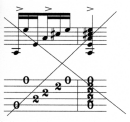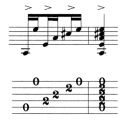
Soleares rhythm
Soleares, or soleá, is one of the most important styles of flamenco singing, guitar playing and dancing. It has a peculiar rhythm (or compás) that is found in other styles of flamenco, such as alegrías and other members of the cantiñas group. The soleá rhythm consists of twelve beats accented on 3, 6, 8, 10 and 12. Tension starts on 3, increases on 6, peaks on 8 and resolves on 10. Because of the asymmetrical distribution of the accents, we can interpret the twelve beats in different ways: a full set of twelve; two sets of three and three sets of two (3+3+2+2+2=12); or four sets of three (3+3+3+3=12), with the first two sets of three accented on the third beat (1, 2, *3*), the third set accented on the second beat (1, *2*, 3), and the fourth set accented on the first and third beat (*1*, 2, *3*). Look at the diagrams below:
One set of twelve beats, accented beats in parentheses:
Two sets of three beats and three sets of two beats (3+3+2+2+2=12):
Four sets of three beats (3+3+3+3=12):
Most transcriptions of flamenco guitar, including my own, use the last system in order to package the rhythm neatly within a simple 3/4 time signature. Check the soleares samples to see how this notation appears.
The bulerias rhythm is basically a double-time version of soleá.
Siguiriyas rhythm
The siguiriyas rhythm is similar to the soleá rhythm in that it can be interpreted as having twelve beats with the same intervals between accented beats. However, the siguiriyas rhythm starts and finishes at different points in comparison to the soleá rhythm, and tension and resolution also happen at different moments. If we use the same counting taken from soleares, this rhythm will start on beat 8:
The tempo here is faster than in soleares, making it more logical to count only the accented beats in a framework of five asymmetrically arranged beats. If we adjust the counting to reflect these differences, we end up with this:
The counting of the rhythm is no longer "linear" because some of the beats are longer than others: Beats 1, 2 and 5 are of the same length (two eighth notes in the above diagram), and beats 3 and 4 are one-and-a-half times that amount (three eighth notes). This is worth careful consideration: In sixteenth notes, the pattern would work out to four notes in beats 1, 2 and 5, and six in beats 3 and 4, and in sextuplets there would be six and nine notes, respectively.

The six sixteenths in beats 3 and 4 of the second example should be expressed in a way that highlights the ternary nature of the idea (three sets of two) and not a binary interpretation (two sets of three). In this sense, the images below show two ways of playing a classic remate. The symbol ">" indicates an accent. Use the same fingering for both; the difference lies in the accents.


Historically, the siguiriya has not been well represented in musical notation. Most transcriptions use alternating 3/4 and 6/8 meters, although in this format, the compás would have to start on beat 5, as seen below:

The use of thick bar lines makes it easier to read the notation and results in a three-part rhythm of one measure of 2/4 (beats 1 and 2), one measure of 6/8 (beats 3 and 4) and one measure of 1/4 (beat 5), as seen below:

In this way, the rhythm is much more accurately represented while avoiding a radical departure from the system used until now. See the samples to get a better idea of this.